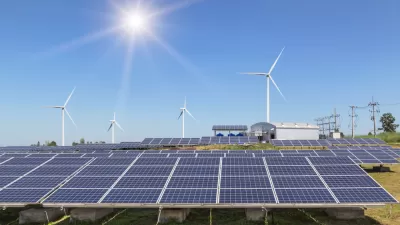Voters in two Western states next month will determine whether to require energy utilities to increase their share of electricity from renewable sources to 50 percent by 2030. In Arizona, the campaign has become the costliest in state history.

NextGen Climate Action, a political action group launched by environmentalist Tom Steyer's NextGen America, wants to see states adopt tougher Renewable Portfolio Standards (RPS) that would require energy utilities to derive a higher percentage of the electricity they sell from renewable sources by a target date in order to mitigate climate change by reducing greenhouse gas emissions.
According to the National Conference of State Legislatures, 37 states and the District of Columbia had adopted RPS as of July 20, although eight had voluntary goals. The strongest were Hawaii, at 100 percent by 2045, and New York and California, at the goal set by NextGen: 50 percent by 2030. Last month, California joined Hawaii in adopting the same target when Gov. Jerry Brown signed Senate Bill 100 by Sen. Kevin de León (D-Los Angeles).
"Roughly half of all growth in U.S. renewable electricity generation and capacity since 2000 is associated with state RPS requirements," according to a Lawrence Berkeley National Laboratory report [pdf] released in July 2017.
NextGen Climate Action chose three states, Arizona, Nevada and Michigan, all of which had existing RPS, to increase the required percentage of renewable energy to fifty percent by 2030.
- The campaign in Michigan, which has a 15 percent renewable energy standard by 2021 and a 35 percent goal by 2025, achieved success when the NextGen state group, "Clean Energy, Healthy Michigan," came to an agreement on May 18 with DTE Energy (formerly Detroit Edison) and Consumers Energy in setting a target goal "of at least 50 percent clean energy by 2030, to be achieved through a combination of investments in at least 25 percent renewable energy, and the remaining through energy efficiency," according to the Michigan Climate Action Network.
- The campaign in Nevada, which has a 25 percent RPS by 2025, required gathering signatures and going to the ballot. Question 6, the Renewable Energy Standards Initiative, is on the ballot on Nov. 6 as an initiated constitutional amendment. If it passes, electric utilities will be required to acquire 50 percent of their electricity from renewable resources by 2030.
The state's largest public utility, NV Energy, a Berkshire Hathaway subsidiary providing 90 percent of Nevada's electricity, had not taken a position on the initiative as of Sept. 24, according to James DeHaven of the Reno Gazette Journal. "The measure faces little organized opposition and is widely expected to pass in November. If so, it would have to survive a second vote in 2020 before becoming law."
The reason for the low profile appears to be it's heavy investment in fighting Question 3, also an initiated constitutional amendment, which "would kill NV Energy’s electric power monopoly and allow consumers to pick their own power provider by 2023," reported DeHaven on Oct. 8. The measure "is by far the best-funded, highest-profile measure on November’s ballot."
"A host of prominent clean energy and environmental groups have joined NV Energy in opposing Question 3," adds DeHaven on Sept. 24. "Question 6 enjoys support from a similar set of organizations, among them the Sierra Club, the Nevada Conservation League and Western Resource Advocates."
In Arizona, Proposition 127, an initiated constitutional amendment on the Nov. 6 ballot calling for 50 percent renewable energy generation by 2030 for public utilities, is being fiercely fought by the state's major utility, Arizona Public Service Co. (APS). The state's RPS calls for 15 percent renewables by 2025. Currently, the nation's sunniest state only gets 6 percent of its power from the sun.
The parent company of APS, Pinnacle West Capital Corp., has spent almost $22 million through Sept. 30 to oppose the initiative, while the NextGen group, Clean Energy for a Healthy Arizona, has spent almost $18 million, according to Ryan Randazzo, business reporter for The Arizona Republic.
Renewable vs. carbon-free
Should Prop. 127 pass, APS warns that the Palo Verde Nuclear Generating Station, the largest power plant in the U.S. by output, averaging 3.3 gigawatts, that serves 4 million people, could be forced to close, reported Randazzo in April. While nuclear power is carbon-free, it is not renewable.
The nuclear plant is a crown jewel for the utility, generating about one-fourth of its energy supply. The three nuclear generators are co-owned by seven utilities in Arizona, California, New Mexico and Texas.
The company also warns that other "base-load" suppliers, like coal-burning power plants, would also be forced to close, which is what the proponents want due to coal being the most polluting fossil fuel. They contest the claim that Palo Verde would close.
Effective or pragmatic?
A related post in March 2017, "Surprising Trump Effect: Many States Seek to Ramp-Up Renewable Energy Mandates," questions the popularity of renewable portfolio standards. While effective at reducing greenhouse gas emissions, it is not the best tool, according to Jay Apt, co-director of the Electricity Industry Center at Carnegie Mellon University. But from a political perspective, meaning how good a chance it stands of being passed into law, they do well, he adds.
"Many economists would prefer a carbon tax or cap-and-trade regimen to a mandate," reports Benjamin Storrow for E&E News in the source article (paywalled).
A carbon price is more flexible and less costly, they reason. Instead of requiring power companies to adopt technologies like wind and solar, a cap or tax leaves it to the market to identify the least-costly compliance options.
While not a carbon tax, Initiative 1631 on the Washington state ballot next month (posted here in August) is a carbon fee and operates much the same way.
The National Resources Defense Council and the Grand Canyon Chapter of the Sierra Club [pdf] support Prop. 127 while Tucson Electric Power and Chicanos Por La Causa oppose it.
Related in Planetizen:
-
Utilities Still Catching Up to Public Opinion on Renewable Energy, September 15, 2018
-
Las Vegas to Go 100 Percent Renewable Energy by 2017, November 26, 2015
-
State Political Winds Turn Against Renewable Energy, January 26, 2015
Hat tip to Ballotpedia.
FULL STORY: Clean-energy ballot measure Prop. 127 now the most expensive in Arizona history

Alabama: Trump Terminates Settlements for Black Communities Harmed By Raw Sewage
Trump deemed the landmark civil rights agreement “illegal DEI and environmental justice policy.”

Planetizen Federal Action Tracker
A weekly monitor of how Trump’s orders and actions are impacting planners and planning in America.

Why Should We Subsidize Public Transportation?
Many public transit agencies face financial stress due to rising costs, declining fare revenue, and declining subsidies. Transit advocates must provide a strong business case for increasing public transit funding.

Understanding Road Diets
An explainer from Momentum highlights the advantages of reducing vehicle lanes in favor of more bike, transit, and pedestrian infrastructure.

New California Law Regulates Warehouse Pollution
A new law tightens building and emissions regulations for large distribution warehouses to mitigate air pollution and traffic in surrounding communities.

Phoenix Announces Opening Date for Light Rail Extension
The South Central extension will connect South Phoenix to downtown and other major hubs starting on June 7.
Urban Design for Planners 1: Software Tools
This six-course series explores essential urban design concepts using open source software and equips planners with the tools they need to participate fully in the urban design process.
Planning for Universal Design
Learn the tools for implementing Universal Design in planning regulations.
Caltrans
Smith Gee Studio
Institute for Housing and Urban Development Studies (IHS)
City of Grandview
Harvard GSD Executive Education
Toledo-Lucas County Plan Commissions
Salt Lake City
NYU Wagner Graduate School of Public Service




























